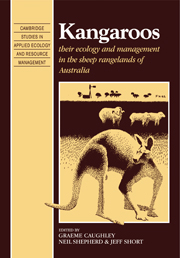Book contents
- Frontmatter
- Contents
- Preface
- Dedication
- THE STUDY AREA IN CONTEXT
- 1 Introduction to the sheep rangelands
- 2 The environment of the Australian sheep rangelands
- 3 The effect of weather on soil moisture and plant growth in the arid zone
- 4 Plant dynamics
- 5 The diet of herbivores in the sheep rangelands
- 6 Factors affecting food intake of rangelands herbivores
- 7 The mobility and habitat utilisation of kangaroos
- 8 Kangaroo dynamics
- 9 Condition and recruitment of kangaroos
- 10 Ecological relationships
- 11 Options for management of kangaroos
- Appendices to Chapter 8
- REFERENCES
- Author index
- Subject index
11 - Options for management of kangaroos
Published online by Cambridge University Press: 05 November 2011
- Frontmatter
- Contents
- Preface
- Dedication
- THE STUDY AREA IN CONTEXT
- 1 Introduction to the sheep rangelands
- 2 The environment of the Australian sheep rangelands
- 3 The effect of weather on soil moisture and plant growth in the arid zone
- 4 Plant dynamics
- 5 The diet of herbivores in the sheep rangelands
- 6 Factors affecting food intake of rangelands herbivores
- 7 The mobility and habitat utilisation of kangaroos
- 8 Kangaroo dynamics
- 9 Condition and recruitment of kangaroos
- 10 Ecological relationships
- 11 Options for management of kangaroos
- Appendices to Chapter 8
- REFERENCES
- Author index
- Subject index
Summary
Introduction
There are only three ways that we can manage a population of wildlife. We can control it or even exterminate it, we can utilise it to provide a continuing yield, or we can cherish it for its intrinsic worth. The decision as to the right option will be determined mainly by what we consider the appropriate use of the land on which the animals live. A population of kangaroos living in a paddock of wheat will not be viewed in the same way as one living in an unutilised desert.
In this chapter we explore the options available for managing kangaroos on two classes of land – national parks and nature reserves, the perceived primary function of which is to conserve, and rangelands whose perceived primary function is to produce. Most people agree on the primary function of those classes of land, but when those broad functions are specified more fully they reveal an underlying layer of secondary objectives which may conflict with each other. These in turn, depending on the ranking assigned among them, generate a range of procedures whereby kangaroos might best be managed.
Management within national parks
The appropriate management is determined less by what is happening on the ground than by perceptions of what the national park is for. We will trace the history of these changing perceptions to show how they determine the ‘appropriate management’ of the soil, plants and animals within the parks.
- Type
- Chapter
- Information
- KangaroosTheir Ecology and Management in the Sheep Rangelands of Australia, pp. 188 - 219Publisher: Cambridge University PressPrint publication year: 1987
- 11
- Cited by



